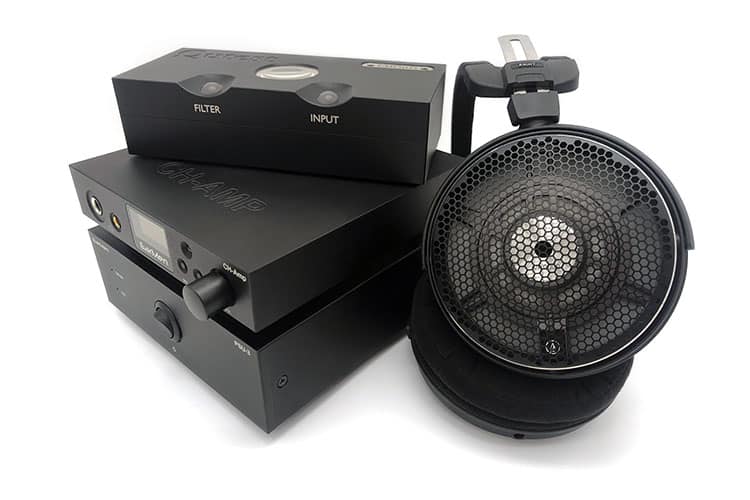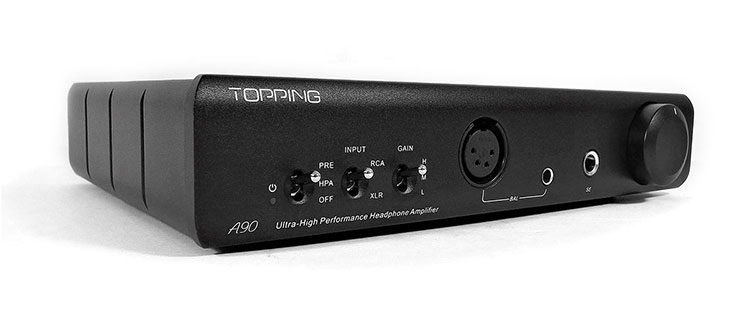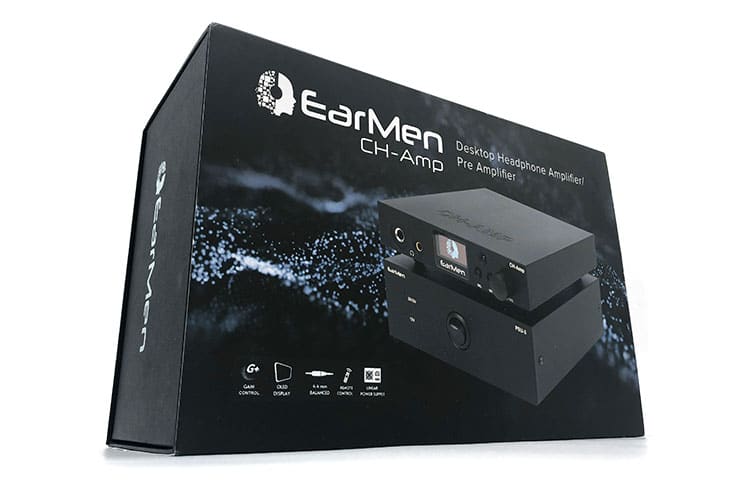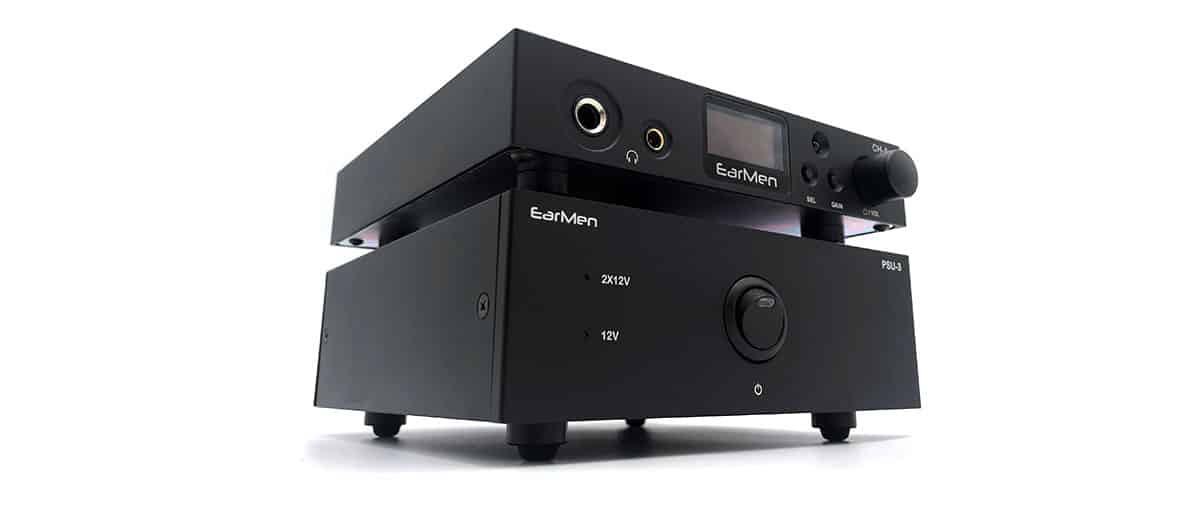Synergy
Power
The volume setting of the CH-Amp unusually maxes out at thirty. But for such a limited range it does provide a lot of headroom since the first increment is a huge jump followed by smaller strides in loudness.
To reach the rated potential 3.8W power capability of the CH-Amp it is advisable to use a balanced capable source. Either way, the CH-Amp won’t say no to challenging loads even when running single-ended that’s rated to 1.5W in high gain.
With the inefficient 420W drivers of the Audio-Technica ATH-ADX5000 and the planar magnetic Dan Clark Audio Ether 2, I only crept up between eight to eleven depending on the song.

Pairings
Since I, unfortunately, didn’t have on hand the Tradutto, the moment I laid eyes on the CH-Amp, my immediate reaction was to see if the Chord Qutest will stack nicely on top. With only a slight OCD-inducing overhang, this setup proved to be a close match in completing the aesthetic the CH-Amp is going for.
Aside from the Qutest, I also used the DAC output of the Burson Conductor 3R to test which was an easy task since the CH-Amp has two RCA inputs.
The Qutest bravely added speed and zing to a dynamic electric guitar section which prompted me to dial it down a bit. With a more level-headed and controlled presence, the Conductor 3R still easily pushed richness to the scene.
Of the two DACs, the Qutest is the one taking sound in a more approachable manner. Unlike the drier timbre of the Conductor 3R, the Qutest is more natural and weightier which is a nice pairing to headphones like the ATH-ADX5000 introducing some much-needed muscle.
Utilizing the CH-Amp as much as the ATH-ADX5000 whose brighter characteristics could be easily fatiguing to some, the Ether 2 in response offers tons of detail and at the same time quells shouty areas. Thick and relaxed, chimes will still push through but the Ether 2 will smoothen the sparkle a bit for a velvety resonance.
The flat sound of the Ether 2 is not as exciting as the ATH-ADX5000 but the calmness closes off the scene without breaking off the picture’s balance. Only upon dissecting the low-end where the speedy nature of the ATH-ADX5000 truly shines with the CH-Amp does the slower bass response of the Ether 2 may be ruled out.
Select Comparisons
Burson Conductor 3 Reference
Technical
Those who have been around will know that the Conductor line has been around since 2007. And justifiable for a successful line that needs to prove its salt in the modern era, Burson took its time making sure it will be worth the attention.
Like the CH-Amp, Burson is making sure the Conductor 3R is juiced with no compromise. But instead of going for an external power supply, the Conductor 3R comes with five of Burson’s breakthrough Max Current Power Supply (MCPS) inside of the chassis pushing noise beyond audible by raising the voltage frequency to 170kHz.
On paper, the Conductor may seem like a behemoth in being able to dish out 7.5W of power. Dig deeper though and it will be a closer match with the CH-Amp since the Conductor 3R offers 5W of power for the same 32Ω loads.
Something the CH-Amp won’t have a say in is the easily swappable op-amps inside the Conductor 3R. It may be an unnecessary feature to those who like their gear stock but the search for that perfect op-amp matching is a thing.
The two may be closely priced but the Conductor 3R is not a pure analog amplifier like the CH-Amp. It tucks in two ES9038Q2M and a Bluetooth receiver from Qualcomm in its belly making it a seriously capable DAC as well.
Design
Unlike its smaller sibling the Funk, the Conductor 3R follows the same method as the CH-Amp in hiding four screws at the bottom of the chassis to remove any visible obstruction. Remove the four screws of the Conductor though and it will let you split the case in half for easy access to the op-amps inside.
Of the two, Burson’s DAC/Amp is the chunkier and wider one. And with its space grey cool case that has low profile fins running the length of the device, it is also the more eye-catching device.
Proudly specializing in single-ended applications, there may be four RCA sockets at the rear but there will be no way to run the Conductor 3R balanced. Look at the front and in exchange for a 4.4mm jack present in the CH-Amp, it offers a second 6.35mm headphone output that runs simultaneously.
Being a DAC/Amp, the Conductor 3R also has an OLED screen showing the different settings and information to provide feedback. It has a deeper set of functionalities controlled by the four buttons below and the digital volume wheel.
Performance
Close but not the same, the punchier low-end of the CH-Amp outshines the lighter bass response of the Conductor 3R. The CH-Amp humbly invites more appreciation to each deep note and delineated twang.
With the calm and collected Conductor 3R still in play, its strength lies in building a tidier picture. The bass extension painted in both devices isn’t that much different though in a more dynamic and busier scene, the CH-Amp slightly edges Burson with bite.
I wouldn’t call the Conductor 3R weak in the vocal region just because it plays farther out in space. Here, it is a tale of two personalities as the CH-Amp skillfully isolates singers in a flowy manner while the Conductor 3R adds lightness and texture.
The reverb and body of a piano are more natural and attention-grabbing over at the EarMen camp. On the other side, guitars may have a leaner twang but the presence comes through much stronger even considering its more distant placement.
Expect a more excitable treble region when listening to the CH-Amp. The Conductor 3R is less attacking in this regard but unless you’re pairing the CH-Amp with bright gears, this wouldn’t be as big of a concern.
In recreating a rousing round of applause, the CH-Amp has a more rounded and bodied implementation. The more anemic yet raw-sounding Conductor 3R does feel hurried in a sense but in tackling dispersion and staging it casts a wider space for more breathing room.

Burson Funk
Technical
The basic package of the Burson Funk will get you two NE5532 op-amps preinstalled inside which are easily swappable to any aftermarket op-amps including Burson’s V6 chips. I find the default op-amps lacking in detail and treble extension so the configuration you see here is sporting a pair of V6 Classics.
Both amplifiers are packaged on the smaller side of the spectrum and yet the Funk has a big secret lying behind. Aside from its 3.5W at 16W load Class-A headphone amplifier, it is packing a 45W class-AB speaker amplifier that reduces the desk clutter of nearfield speaker enthusiasts.
What enables Burson to cram all these goodies inside the Funk is their proprietary Max Current Power Supply (MCPS). This is the same MCPS technology that is being used across Burson’s lineup so nothing is being held back considering the entry-level pricing of the Funk.
A huge omission in Burson’s offering is the ability to interface with balanced gears. The Funk is single-ended only and has a more limited IO than the CH-Amp which is a consideration to be made if the speaker output is not needed.
Design
Like a miniaturized Conductor 3R, the Funk is also designed with a cool case that acts as an external heat sink without looking like one. Aside from being visually striking, the added depth brought by the fins and the four screws upfront gives the Funk a more complex charm against the stealthier appeal of the CH-Amp.
From the front, a giant analog volume wheel is prominently performing as the centerpiece of the Funk with its deep and tasteful knurling for grip. Analog through and through, this is why there is no OLED display in sight.
Turning both devices 180 degrees, the Funk looks emptier with its lone RCA input and two sets of binding posts. The CH-Amp here feels like the winner if variety and flexibility in IO are of concern.
Performance
With the V6 Classics installed, don’t expect the same punch and tightness exhibited by the CH-Amp. It is the most immediate tradeoff with the warmer-sounding Funk, at least in return it will exhibit a weightier and more immense low-end thump.
The CH-Amp is the drier device when compared but it maintains its advantage in accentuating more subtle areas where the softer bite on the Funk lags.
Once the difference in detail retrieval sets in, I can’t help but notice certain areas where the Funk smooths out detail that the CH-Amp effortlessly displays. Like in a simple guitar pluck or a piano solo, aside from sounding more mature, the CH-Amp gently adds depth to each key and reverb.
The violin timbre in the Funk sounded a bit kinder focusing on keeping up with detail and extension. Here, the Funk gains me back, especially with snare drums that tap with just the right amount of body and fast attack contributing to realism.
Since the bass on the Funk is more immense and not as solid as the CH-Amp, it affects staging quite a bit and adds to the intimacy. Imaging, which is another strong point of the CH-Amp puts the Funk behind but only when the two are placed side by side or when a bass-heavy song is played.

Topping A90
Technical
When the original Topping A90 came out a lot of enthusiasts were taken in by its technical and sonic traits all at such an attainable price point.
And similar to the CH-Amp that is marketed to form a seamless stack with the Tradutto, the A90 also has a partner in crime, the D90. Both stacks are balanced capable but since the Topping duo has a taller chassis, it was able to fit full-sized XLR sockets although it noticeably lacks a second RCA socket to match the CH-Amp.
What’s running inside the A90 is Topping’s in-house NFCA module that supplies both the headphone and preamplifier outputs with analog goodness. But don’t take the cheaper A90 for granted when it comes to power since it will not shortchange by almost doubling what the CH-Amp has on tap.
Design
To be honest, I’m liking the new design of the A90 Discrete. Still, the A90 here is a sleek purely analog old-school device that is plug and play as established by its snappy toggle switches and noticeable lack of a display.
It has a wider chassis that unlike the squared-off form of the CH-Amp has little hints of curves and ridges to make it a little bit more sophisticated. Topping applied this in a very conservative sense since, like its other siblings, the priority here is functionality and usability instead of going for loud aesthetics.
Quite similar but different to the CH-Amp that goes on standby once the PSU-3 sends it power, the A90 also has a separate switch at the back to physically turn on the power supply in addition to the one on the front to wake the unit from standby.
The A90 though does not automatically switch outputs depending on what is plugged in. You’ll have to manually select whether the output you prefer is to the front or rear by flipping the same toggle used to turn on the device.
Performance
The A90 is famous for its sterile yet highly incisive quality. So, it comes as no surprise that the CH-Amp has the more engaging bass region that is not only stronger in punch but is also not as thin.
There’s no denying the sense of speed the A90 can give to its low-end. Not too far apart in this regard, the CH-Amp isn’t allowing the A90 space to breathe too easily by drawing up a deeper sub-bass extension and crisper bass guitar delineation.
A huge Achilles heel to the A90 when it was first gaining popularity is its clinical and brighter leaning. Even compared with CH-Amp, this trait is likely to be more fatiguing in the long run.
While on paper the A90 has an impressively low THD+N, I still find the CH-Amp to be the amplifier with the blacker background. Listening to the same song, I can hear the singer and the void left in between separating it from the neighboring instruments.
Unless placed side by side, what’s impressive about the A90 is its skill in detail retrieval. Still, with a key press of the Piano, the CH-Amp easily trumps the A90’s valiant effort by peeling an extra layer of depth.
And while I praised the A90 for being revealing, it does begin to diverge in clarity in the treble region. Electric guitars to start do not sound as dynamic and engaging as it loses some control and character in addition to the timbre being thinner.
Imaging and placement are still in the CH-Amp territory as it emphasizes each object more strongly. The A90 has a finer and smaller presence but with the benefit of offering in return a slightly deeper stage.

Our Verdict
The EarMen CH-Amp is aptly named with no need for a timeout as it is always ready to land punches as an insightful headphone amplifier in delivering a transparent and smooth sound.
It isn’t every day that we see an amplifier coming in default with a custom-built external power supply. So, it may not be immediately obvious looking at the deceptively understated mien, but everything EarMen has done is in one way or another a form of answer in their quest for great sound.
Depending on what you’re looking for in an amplifier, the positives of this setup are detail retrieval and its dark background. But tuned on to the exciting side of the spectrum, pair it poorly and the dreamlike impression will quickly fade away once fatigue sets in.
With a lot to like and only a few minor quirks to get around, this amp from EarMen will surely be a reliable partner for a lot of audio enthusiasts out there.
EarMen CH-Amp Specifications
- Input: 2 x RCA, 1 x 4.4mm balanced
- Output: 6.35mm SE, 4.4mm balanced
- Pre output: RCA, 4.4mm balanced
- Power output: 1.5W (SE Input), 3.8W (Balanced Input)
- Gain SE: 260mW (Low), 1.5W (High)
- Gain Balanced: 1W (Low), 3.8W (High)
- Dimension: 150x30x150mm
- Weight: 550g
- PSU Dimension: 150x60x150mm
- PSU Weight: 1590g




